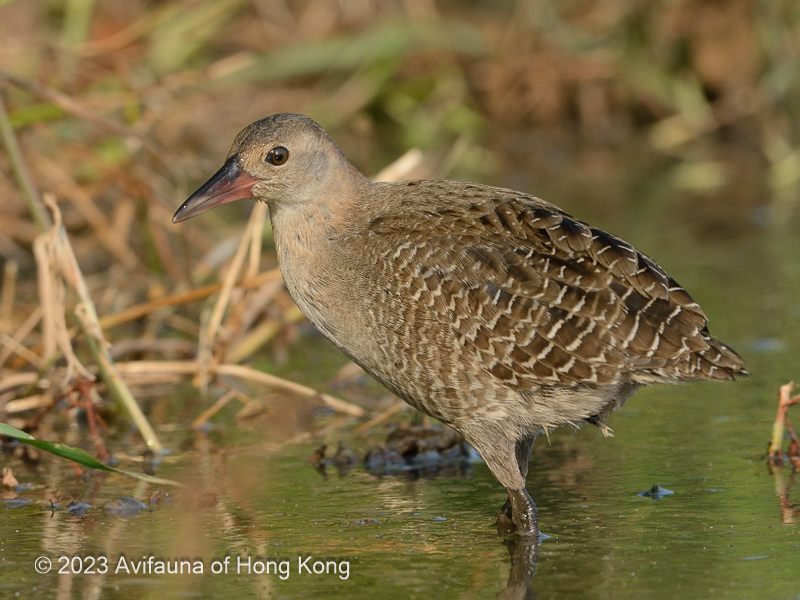Slaty-breasted Rail Lewinia striata 灰胸秧雞
Category I. Scarce resident and rare migrant in wetland habitats both brackish and freshwater. Appears to be in decline.
IDENTIFICATION

Mar. 2014, Michelle and Peter Wong.
25-30 cm. Adult has obvious rusty-brown crown and nape, brownish upperparts with irregular white and blackish barring that extends to the tertials, flanks, vent and uppertail. Underparts otherwise greyish with a pale throat. Bill medium in length with a fairly deep base. Eyes reddish, bill greyish culmen with deep pink base. Females are duller and have more whitish colouration on the belly.

Aug. 2019, Kinni Ho.
Immatures are much browner and lack warm colours on head. White barring is slightly narrower, while dark barring is broader; pale throat is more extensive. Underparts are brownish and the eyes are dark. Bill duller than adult.

Aug. 2018, Kinni Ho.
Juveniles are all black, similar to the young of White-breasted Waterhen.
VOCALISATIONS
The song is a series of ‘kik’ notes that often begin rather hesitantly but are then run together at approximately four notes per second when in full flow. A similar note may be uttered singly as a call.
Taylor and van Perlo (1998) also report a ‘sharp but not loud whistle’, a ‘noisy ka-ka-ka’, and a ‘low kuk’ (probably the same as above) or ‘ka-ka-kaa-kaa’call when the male courts the female.
Vocalisations have been heard in most months of the year, the exception being late summer, which may reflect the stage of the breeding cycle.
DISTRIBUTION & HABITAT PREFERENCE
Most records are from the Deep Bay area, where it shows a preference for areas of mangrove and brackish water, in particular managed gei wai at MPNR. Away from Deep Bay, it occurs in both mangrove and other wetland habitats such as areas of seasonal or permanent freshwater marsh and overgrown irrigation ditches in agricultural areas. In recent years has most often been recorded at Long Valley, where it has frequented cultivated rice fields; also recorded at Lam Tsuen, wetland areas on Lantau such as Tai O and Pui O, Luk Keng and Kuk Po, and Yung Shue O.
The first breeding bird survey in 1993-96 recorded Slaty-breasted Rail in 1.2% of squares, with confirmed or probable breeding occurring in six 1km squares, five of which were around the margins of Deep Bay. The remaining squares where the species was recorded were located in the northeast New Territories, Sai Kung and on Lantau at Pui O and Mui Wo. However, the species was not recorded at all during the 2016-19 surveys.
In the 2001-05 Winter Atlas it was recorded in three 1km squares at Tai O, Deep Bay and northeast NT, but not during the equivalent surveys in 2016-19. Despite this being an unobtrusive species that can easily remain undetected, taken together these figures suggest a decline occurred in the intervening 20 years.
OCCURRENCE
Usually, singles are encountered. The highest count is at least 15 estimated to be present at Mai Po on 1 June 1969; otherwise, counts of seven or eight birds refer to adults with chicks. The highest non-breeding season count is five on 17 January 1988 at Mai Po in the intertidal area.
There is evidence that migration takes place, as it has been recorded at more widespread places (such as Sha Lo Tung and Tung Lung Chau) in the non-breeding and migration seasons. In addition, two collided with a building in Central on the night of 23 October 1970, two were present on Po Toi on 9 April 2005, with one there on the 17th, one was hit by a helicopter on 13 October 2015, and injured birds were picked up in urban Kowloon on 13 October 2017 and 2 May 2019.
Kershaw (1904) stated it was not common, while Vaughan and Jones (1913) wrote it was a ‘local resident, confined apparently to the coast…common about Castle Peak Bay and abounds in some of the country around Mirs Bay.’ Herklots (1967) stated it was recorded throughout the year and may breed.
BEHAVIOUR, FORAGING & DIET
Slaty-breasted Rail forages unobtrusively in densely vegetated wetlands at the surface of the ground or just below and from lower parts of vegetation. It is presumed to take invertebrate prey.
Secretive and infrequently observed, though it occasionally comes into view for prolonged periods of time, such as at the edge of Deep Bay mangrove.
BREEDING
Adults have been seen with young from 26 June to 11 August and on 2 October, with as many as six chicks being seen.
RANGE & SYSTEMATICS
The taxon occurring in southeast China, including HK, is L. s. jouyi. Five other subspecies are recognised, of which L. s. albiventer extends to south China and L. s. taiwana occurs in Taiwan.
Ranges from the India (where it is patchily distributed) and Sri Lanka through Bangladesh, Myanmar and parts of Indochina south to Indonesia and the Philippines. Occurs in extensive areas of mainland China, mainly south of the Yangtze River, as well as Hainan and Taiwan.
CONSERVATION STATUS
IUCN: Least Concern. The population appears to be increasing.
Herklots, G. A. C. 1967. Hong Kong Birds (2nd ed.). South China Morning Post, Hong Kong.
Kershaw. J. C. 1904. List of birds of the Quangtung Coast, China. Ibis 1904: 235-248.
Taylor, B. and B. van Perlo (1998). Rails. A Guide to the Rails, Crakes, Gallinules and Coots of the World. Pica Press, U.K.
Vaughan, R. E. and Jones, K. H. 1913. The birds of Hong Kong, Macao and the West River or Si Kiang in South-East China, with special reference to their nidification and seasonal movements. Ibis 1913: 17-76, 163-201, 351-384.

